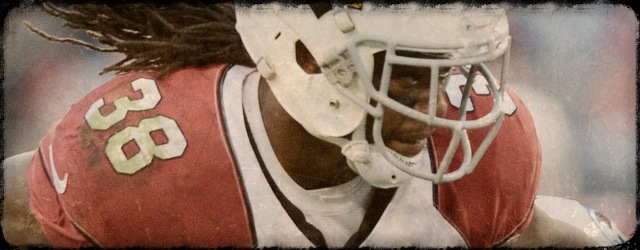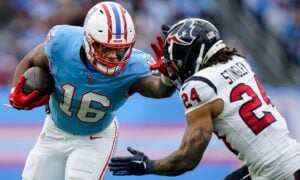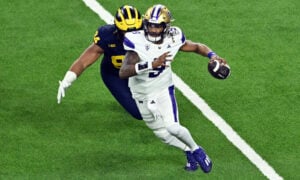The DLF Mailbag

Welcome to the latest edition of the weekly mailbag.
Send me your questions using the DLF Mailbag Form and I’ll include the best in future articles. Remember the guidelines to have the best chance at seeing your question get posted:
1.) Dynasty questions only, no start/sit questions
2.) Help me help you by providing sufficient information about your league (e.g. line-up requirements/PPR or non-PPR/etc.), and include your first name and where you’re from.
3.) Your chance of getting your question answered is inversely proportional to the length of the question.
Let’s get to it!
1. Guard Jonathan Cooper is set to return to the Arizona Cardinals after a significant injury. Tackle Branden Albert is reportedly the Cardinals top target in free agency. I own Andre Ellington and wonder how much this would boost Ellington’s value. Further, I was wondering if there is historical precedent for a team adding two very good run blocking linemen and its effects on running backs. – Chris in Chuck in SC
According to the February ADP data, Cardinals’ running back Andre Ellington is being selected in the early sixth round, as the overall RB21. This puts him behind players he out-performed (Trent Richardson, RB15 and Montee Ball, RB16), players with workload and injury concerns (Shane Vereen, RB14 and Arian Foster, RB20) and a player who has yet to prove a thing in the NFL (Christine Michael, RB19). Though I’m not suggesting Ellington should be selected as a RB1, I have a tough time understanding the relative lack of respect.
A few months ago I described why I believe Ellington is primed to break out, and the overhaul of a putrid offensive line can only help. Despite underwhelming play from his lineman, Ellington still managed to lead the league with a 5.5 yards-per-carry average while also chipping in a 9.5 yards-per-catch average across 39 receptions (as an aside, numbers like these are why I cringe every time the “bad OL” excuse is made for Le’Veon Bell). This resulted in a number-one ranking for the True Points per touch statistic (fantasy points less points scored from receptions and touchdowns, divided by touches) of 0.652, showing a sublime ability to operate with the ball in his hands. Simply put, the guy is lightning in a bottle.
Recent off-season reports have stated Ellington has added ten pounds to his frame in order to accommodate an increase to the 10.5 touches per game he received in 2013. Should he combine those touches with a similar efficiency, it’s entirely possible Ellington could function as a mid-to-high end RB2. Having Jonathan Cooper and potentially Branden Albert on board would be the feather in the cap for Ellington’s value.
To the second part of your question, a quick glance of roster makeovers show that two teams added multiple high-end offensive lineman in 2013 – the Tennessee Titans and Philadelphia Eagles. The Titans drafted rookie Chance Warmack in the first round, and also added guard Andy Levitre in free agency. Ultimately though, the change made little difference as Tennessee fell from 4.5 yards-per-carry in 2012 to 4.1 this past year.
Conversely, by virtue of gaining rookie Lane Johnson and tackle Jason Peters (returning from injury) the Eagles wound up leading the league in rushing. This included ball carrier LeSean McCoy accumulating over 1,600 rushing yards, and the offense averaging 5.1 yards-per-carry as a whole. If the Cardinals can improve similarly to the Eagles, the only limit for Ellington is the amount of times he touches the ball.
2. In my 12-team PPR league I’m fairly thin at running back but fairly deep at receiver. I recently traded pick 1.01 for picks 1.08, 1.09 and 1.10. My thinking was that while I love Sammy Watkins, this is a very deep draft and I could get three very solid players at the end of round one, including 1-2 running backs. Was I crazy for making this trade? – Jake in MI
I don’t think you were crazy at all. Both Tim Stafford and I detailed Sammy Watkins in last week’s Mailbag, and suffice it to say there’s no reason why he shouldn’t be considered the draft’s consensus top player. With that said, you received quite the haul in return, as 2014 could very well go down as one of the deepest drafts in recent memory.
With your trio of picks at the end of the first, you’ll have a great shot of obtaining two top running backs, as well as a second-tier receiver such as Kelvin Benjamin or Allen Robinson. Should one of the draft’s top tight ends wind up in a desirable landing spot, you could even look to that position instead. In terms of relative value, if you can hit on two of those picks and receiving quality starting output, that’s a great return, even for a player like Watkins.
I think my only qualm with your decision is that, as a contending team, it might’ve been prudent to see if you could obtain the services of veteran players instead of a stockpile of draft picks. While never a completely accurate indicator of value, the February ADP suggest that players such as Zac Stacy, Marshawn Lynch and DeMarco Murray carry a similar value to that of Watkins. As your league’s draft approaches, that value is likely to increase even further. Regardless, I still think you made out well here.
3. In terms of rookie draft picks where would you value Jarrett Boykin in a PPR league? Is he worth a mid-second rounder, or would his value fall later? – Bob in Earth
At this point it seems inevitable that the Packers will open the 2014 season without either receiver James Jones or tight end Jermichael Finley on the roster. This means that there will be a giant talent vacuum behind stars Jordy Nelson and Randall Cobb, and someone will have to step up to fill the void. Enter Jarrett Boykin.
Despite underwhelming play from Green Bay quarterbacks not named Aaron Rodgers, Boykin still finished the season with 49 receptions for 681 yards and three touchdowns – good for a ranking as the overall PPR WR52 in just 12 games played (not including weeks 1-4 where he was solely a special teamer). This is roughly in line with how the third option in the Green Bay passing game has performed, as dating back to 2009 that position has yielded a seasonal average of 51 receptions for 693 yards and 5.5 touchdowns.
To me, those numbers are more indicative of a spot-starter or low-end FLEX than a future fantasy stud. Moreover, given the drafting and usage of running back Eddie Lacy, it’s fair to assume that the Packers will adopt a more balanced offense. The combination of these factors cast doubt on Boykin’s fantasy viability.
Continuing, the Packers have already expressed a desire to re-sign Nelson, and Cobb is just entering the prime of his career. Barring injury, it’s tough to envision Boykin surpassing either. When it comes to your bench spots, I’d prefer to roster a player with a higher upside, so I think a mid-second round pick is too high for Boykin. If you can snag him for an early-to-mid third round selection, I’d be content.
4. We are starting complete 32-team dynasty league with 43-man rosters, full IDP and two sets of players (no two of same player can be on one team). The veteran draft is serpentine, and the rookie draft order is inverse to that of the veteran draft. I have the third pick to choose any draft position, and was wondering what the best strategy is? I was thinking spot 32, so I can get the first pick in rookie draft. – Craig in IL
Given your league specifications, this ultimately boils down to drafting as if it was a 16-team league. Therefore there really won’t be a huge positional bias, as acquiring studs is the name of the game, regardless of where they line up on the field (yes, even with quarterbacks). Given your ability to virtually dictate where you draft, you now have a reasonable amount of leverage relative to the field.
The prevailing school of thought is that while you won’t win your league with your first round selection, you can certainly lose it. While I admit this line of thinking is more geared towards a re-draft mentality, it definitely works for deep-league dynasties as well. Put succinctly, given how many other owners will be drafting, you don’t want to squander the chance to obtain the services of an elite player.
With that said, it’s also a bonus to be able to pick early in the second round, as well as in the rookie draft. To that end, if you think you can select a player later in the first whose value doesn’t differ dramatically from that of an early-round pick, I think it behooves you to enact that philosophy. This, of course, begs one important question – who do you view as stud players?
For me, I’d be ecstatic to obtain any of Aaron Rodgers, Andrew Luck, Jamaal Charles, LeSean McCoy, Calvin Johnson, Josh Gordon, AJ Green, Julio Jones, Demaryius Thomas, Dez Bryant or Jimmy Graham. Those are who I consider to be the tier-one players relative to their positions, with a drop-off ensuing afterwards. Since there are two copies of each player, as long as I have a top-22 pick, I’ll be guaranteed to draft one of them. The added bonus is I’d also have the 11th pick in the second round, as well as the rookie draft.
I think you should approach your draft in a similar manner – define your top tiers at each position and figure out where your cutoff point is. If that extends to 16 players and you can get away with picking last, then I’d absolutely go for it – but I wouldn’t do so solely to draft Sammy Watkins. Drafting a lesser player in order to gamble on a rookie who may or may not pan out could cripple you in the long run, and give credence to the saying above – you don’t want to “lose” after your first pick.
Follow me on Twitter @EDH_27
- Dynasty Fantasy Football Mailbag: Is Kendre Miller Valued Unfairly? - April 17, 2024
- Forgotten Dynasty Veterans: Bottom Tier - April 9, 2024
- Dynasty Fantasy Football Mailbag: How Much Should You Factor in Off-Field Issues? - April 9, 2024


































































